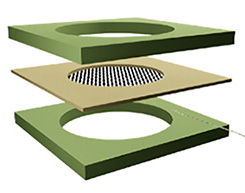
Graphene is frequently lauded for its untapped potential in ushering about a new generation of efficiency and performance, but the super-material has years to go before it becomes a standard in most electronics.
Recent innovations by UC Berkley physicists indicate that microphones and loudspeakers may be the first devices to commercially use graphene in the imminent future; they’ve successfully built lightweight ultrasonic microphones and loudspeakers with greater fidelity than standard radio transmission and the ability to penetrate solid objects such steel, an impossible feat for electromagnetic waves.
The devices can also be used to mimic echolocation, bats and dolphin’s ability to gauge the distance and speed of objects around them. “Sea mammals and bats use high-frequency sound for echolocation and communication, but humans just haven’t fully exploited that before, in my opinion, because the technology has not been there,” said UC Berkeley physicist Alex Zettl. “Until now, we have not had good wideband ultrasound transmitters or receivers. These new devices are a technology opportunity.”

The black mesh represents the an atom-thick layer of graphene
Unlike ordinary microphones and loudspeakers, which use diaphragms made from paper or plastic that vibrate to produce or detect sound, the diaphragms in the new devices are made from graphene sheets that are as thick as a single atom. Being this lightweight allows the diaphragm to respond to a much wider range of electronic pulse frequencies than contemporary microphones and speakers, a huge benefit when using ultrasonic transmitters and receivers to measure distance (as with sonar applications) or to simultaneously send massive amounts of information across multiple frequency channels.
“Because our membrane is so light, it has an extremely wide frequency response and is able to generate sharp pulses and measure distance much more accurately than traditional methods,” explains Qin Zhou, the UC Berkeley postdoctoral fellow who worked alongside Zettl.
Through a specific combination of strength, stiffness, and light weight, the devices can respond to frequencies ranging from subsonic (below 20 hertz) to ultrasonic (above 20 kilohertz) — well outside the 20 to 20,000 hertz range of human hearing. Bats themselves are limited to a range of 9 to 200 kilohertz, whereas the device can operate from bellow 20 hertz to over 500 kilohertz.
What’s more, graphene membranes are very, very efficient at converting the energy driving the device into sound, able to convert 99% of it instead of the mere 8% converted by ordinary loudspeakers and headphones. As such, Zettl anticipates that only a short time awaits before graphene diaphragms find their way into consumer devices like smartphones and headphones.
Source: Berkeley News
Advertisement
Learn more about Electronic Products Magazine





